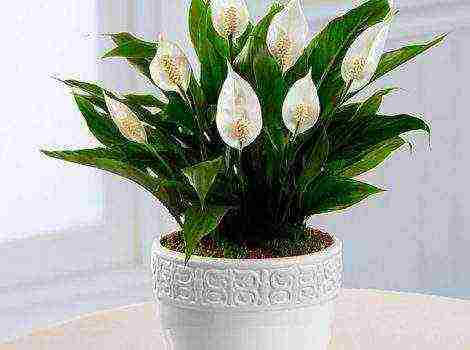Content
- 1 How mango grows in nature
- 2 How to grow mango from seed at home
- 3 Mango tree care at home
- 4 Mango transplant
- 5 Outcome
- 6 Preparing mango seeds for planting
- 7 Planting a sprouted mango seed
- 8 Mango tree care at home
- 9 Video: how to grow a mango tree at home
- 10 Growing mangoes indoors
- 11 Care features
- 12 Obtaining fruits at room conditions
- 13 Grafting mango

Mango is a delicious tropical fruit loved by the people of Russia. Depending on the variety, the fruit tastes like a combination of delicate peach, juicy carrots, sugar pineapple and aromatic strawberries. A pleasant pine scent emphasizes the rich taste.
Almost every housewife, peeling an orange overseas fruit, thought about growing mango from a stone. It will take a lot of time and patience to implement this idea. But all efforts will not be in vain. This amazing mango tree grown from stone at home will become a luxurious decoration of your home.
How mango grows in nature
From its historical homeland - India, the mango tree has settled in the countries of South and East Asia, East Africa and the state of California. A heat-loving plant is terrified of a drop in temperature and may die at +5 degrees Celsius.
The mango tree is a beautiful plant with spreading branches and large green leaves. Under natural conditions, it reaches up to 20 meters in height, overgrown with a wide rounded crown. The roots of the tree go into the ground to a depth of more than 5 meters, which provides constant access to moisture and nutrients. During the flowering period, numerous delicate flowers appear on the branches. After they fall, filamentous panicles remain on the branches, in place of which 2 or more fruits grow. Mango is a real long-liver, the plant can grow and bear fruit for 300 years.
Fruits reach sizes ranging from 5 to 22 cm in length and take on a wide variety of shapes (flattened, ovoid or curved). The peel has a persistent green or yellow color and an overflowing red tint on the sunny side. The weight of the fruit depends on the variety and ranges from 250 to 750 grams. As it ripens, the fruits hang slightly on the long branches of the predecessor flowers. One gets the impression that the fruits are suspended on strings and decorate the tree. Under the dense elastic peel, a bright orange pulp is hidden, carefully preserving a large bone.
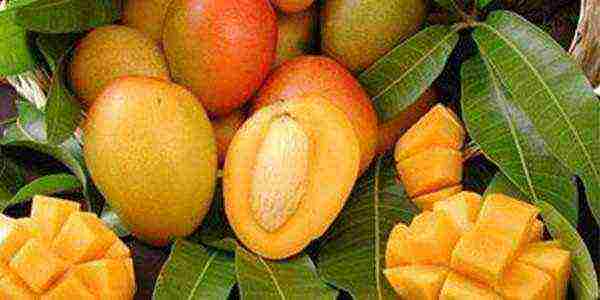
How to grow mango from seed at home
There are two ways to grow a mango tree at home.
The first and simpler one is buying a ready-made seedling in the nursery. The purchased plant must be transplanted into soil and provided with suitable care conditions.
The second method is seed sprouting, for which, first of all, you need to buy a good fruit in the store. Mango color alone will make it difficult to determine ripeness. The green and even color of the skin can hide the fruit no less ripe than the yellow or red skin.
Press lightly on the fruit when selecting it. Perceptible elasticity without excessive hardness or deformation is the most important indicator of ripeness. Examine the tropical fruit carefully - the skin should be intact, slightly shiny and free from spots.
The ripe fruit has a sweet aroma with a slight turpentine scent.The smell of alcohol, on the contrary, speaks of the ripeness of the fruit and the beginning of fermentation processes. When peeling, the pulp of a ripe mango is easily separated from a massive stone, "overgrown" with fruit fibers.
Preparing mango seeds for planting
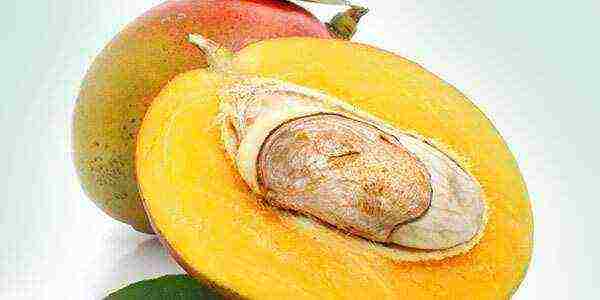
Before sprouting a mango seed, it must be removed from the fruit. Cut the fruit in half and, using a knife, peel the pulp from the kernel. Then rinse the bone thoroughly under running water.
To speed up the emergence of sprouts, it is necessary to free the mango seeds from the seed, which resembles a shellfish. To do this, carefully open the pit and remove the contents that look like large beans.
If the shell is too hard, you do not need to try to break it - there is a very high risk of injury to the sprouts. Place an unapproachable strong bone in a transparent container for several weeks and fill it with water. Provide the future plant with maximum heat and sunlight, do not forget to change the water every few days. After a couple of weeks, as soon as the seed swells, open it from the side and remove the seed.
In the future, a new plant will appear from the germinated seed, so pay special attention to this stage.
- Immediately after removing from the seed, treat the seed with a fungicide to kill the spores of the parasitic fungi. Don't neglect this step. A young seed devoid of a protective bone is an easy prey for fungi and mold.
- Wrap the seed in a damp, breathable cloth or paper towel. The material should be air permeable and not excessively wet. In such conditions, the seed can undergo rotting processes.
- Create a mini greenhouse for the future tree: place the wet material with the seed in dense plastic or in a bag with a zip-lock fastener, and pack it all in a plastic food container with a lid.
- Place the germination structure in a dark place and check the humidity daily.
An alternative system for home germination is a container with wet sawdust, where the seed removed from the seed is placed.
After 2-3 weeks, immediately after the appearance of the first embryos, you can proceed to transplanting into a pot.
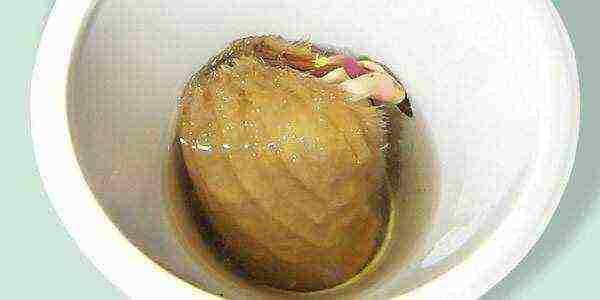
How to plant a mango
You can immediately plant a mango seed in the ground by treating it with growth stimulants, but this method is considered less effective. The point is that the seed protects and preserves the seeds in order to give life to a new plant. New climatic conditions may not be suitable for the protective bone. Therefore, if you immediately plant it in the soil, there is no guarantee that the new plant will begin to grow.
At this stage, as in the previous one, preparation is extremely important. Before planting the seed, prepare the required container and soil.
Under natural conditions, the plant deepens the root system by meters, so immediately pick up a spacious pot so as not to restrict growth. Frequent transplanting can harm and destroy a tropical tree.
- At the bottom of the pot, lay out drainage from pebbles, in a layer of 5-6 cm. This will provide root respiration and protect the plant from stagnant water and decay.
- Fill the pot 2/3 full with the substrate. Mango soil should be lightweight and pH neutral. A universal soil is suitable, the acidity of which can be determined using a special device or paper indicators.
- Make a small indentation and plant the seed, bud 3/4 down, into the ground. If the embryo does not appear after germination, or if you are planting the seed without prior preparation, place it flat side down.
- Mango is a thermophilic plant; it needs certain climatic conditions.
- Immediately after planting, spray the seed with a spray bottle and cover with a domed lid, clear container, or part of a plastic bottle.
- Check the plant periodically, water and ventilate the air in the pot to avoid rotting and death.
- Place the plant in a warm, well-lit area, but avoid direct sunlight.Excess sun is just as dangerous as excessive moisture.
- After 2-3 weeks, the first mango sprout will appear and the greenhouse cover can be removed. Don't worry if the color of the leaves is different. Purple and green leaves are one of the features of the plant.
Mango tree care at home
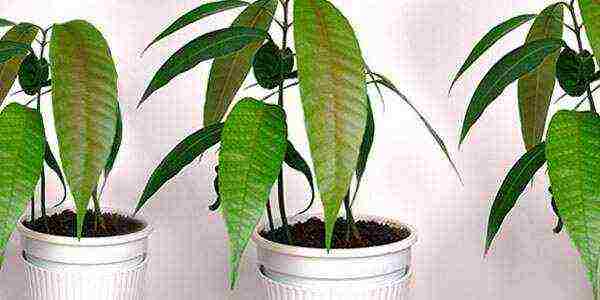
Many people give up the idea of growing mango at home due to the demanding nature of this plant. If you are extremely attentive and anxious, caring for a mango at home will consist of timely watering, access to light, feeding and a timely transplant.
Lighting
Direct sunlight is the only thing that does not harm the tree. So don't be afraid to place it on a lighted windowsill. But dark places should be avoided, the plant will begin to throw off its leaves and may die.
In winter, in order to extend the daylight hours to the required 12 hours, you need to illuminate the mango using a fluorescent lamp.
Air temperature
To grow a healthy and beautiful tree, remember that mango is afraid of any climate change. The optimum temperature is +21 +26 degrees. Therefore, it is not recommended to take it out to the balcony or garden, even in the warm summer period. Sudden rain, sudden changes in air temperature and wind are dangerous for a whimsical plant.
Humidity and watering mango
The plant absolutely does not tolerate dry soil, water the fruit at least 2 times a week. Do not overdo it, an excess of moisture is just as destructive as a lack. Use only settled water at room temperature.
Dry air is also unacceptable for a tropical guest. Moisten the leaves of the plant periodically with a spray bottle, maintain the optimum humidity level (70-80%). Apply a human technical achievement - a humidifier, or surround the pot with containers of water.
Fertilizer
Just growing a mango from a seed is not enough, the plant needs to be fed regularly. Only natural, organic fertilizers and stimulants will go to delicate mangoes. To ensure proper growth, add humus to the tree pot. To do this, make a small circular indentation around the trunk, put fertilizer there and sprinkle it with a small layer of soil on top.
Feed the mango with a fertilizer containing minerals and increased nitrogen once a month. This will preserve the green foliage.
Pruning and shaping the crown
In the wild, the mango grows high up, and the domestic specimen is as good as its tropical parent. If you do not plan to arrange a greenhouse from home, regularly care for the crown of the tree.
When an 8 leaf appears on the seedling, pinch the top. Once the bone tree reaches 1.5 meters in height, start shaping the crown. This usually happens a year after planting. It is better to prune the plant in spring, leaving 5 powerful branches. The places where branches are cut must be treated with garden pitch.
Mango transplant
If you originally planted a tree in a small pot, do not rush to move it immediately after the sprouts appear. Come back to this question in about a year. Mango is a rather capricious plant, sensitive to any changes.
To grow a mango, you need to provide room for root development. After the first year, renew the pot while increasing the height and depth of the container. As soon as the tree reaches the age of 3-5 years, this procedure is carried out no more than 1 time in 3 years.
Even if you take good care of the tree, water it correctly, illuminate it and feed it with useful substances, it is extremely difficult to grow fruits at home.
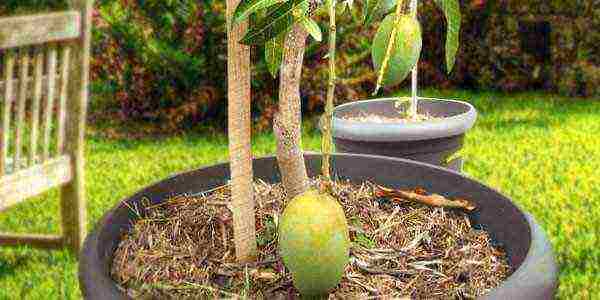
It is possible that at the 6th year of life, the plant grown from the seed will begin to bloom, and after 3 months it will give the first tropical fruits. But most often, to get fruit, a bud of a fruiting specimen from a nursery is grafted onto a homemade mango. After 2 years after the grafting, the flowering period will begin and the tree will begin to bear sweet fruits.
Growing mango from seed at home
The sprouts of this evergreen tree can be purchased in a special nursery and planted at home. This method is preferable, since the survival rate of the seedling is much higher, it is easier to care for it and there is no likelihood of getting a wild plant. However, if you have a seed left from a ripe fruit, then it is absolutely realistic to germinate it and save money on the purchase, following some simple rules.
How to grow mango at home 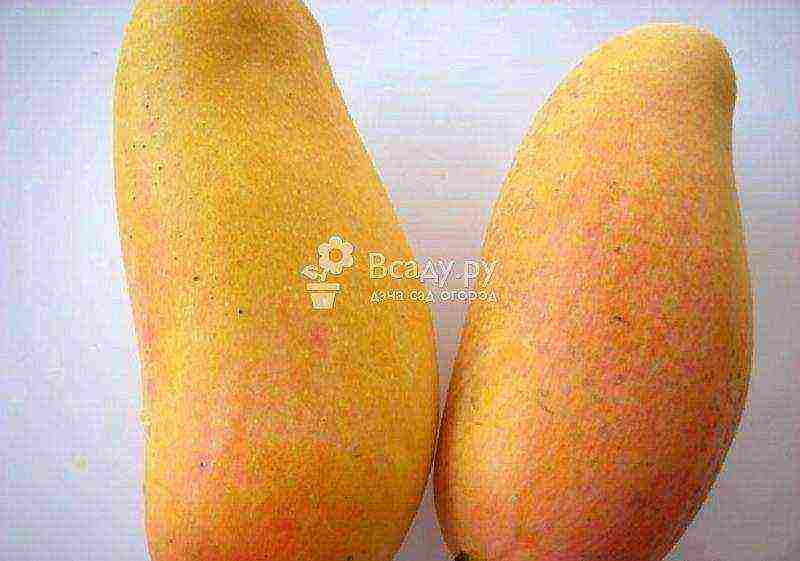 Ripe mango fruits from the store
Ripe mango fruits from the store
Only a fresh bone extracted from a ripe fruit is suitable for planting. Determining the degree of ripeness of a mango is very simple - if the core is easily separated from the pulp, then it is suitable for germination. Rinse it well, then gently scrape off the remaining fruit with a sharp knife. Next, the bone must be split to allow the sprouts to break through faster:
- if it gives in easily, then remove the outer dense layer, carefully pull out the contents that look like large beans, and treat it with a fungicide (a special agent that fights against fungi and harmful spores). If there are several embryos, choose the most green and even, it is he who has the most chances of germination.
- if the shell is very hard, then it is better not to try to make a puncture, so as not to injure the seed. In this case, place the seed in a transparent container of room temperature water for several weeks and leave it on a well-lit windowsill. Remember to change the water every two days so that it doesn't stagnate or bloom.
How to grow a mango at home: getting a bone
Then prepare the pot for planting. Since under natural conditions the mango tree grows from 10 to 45 m in height, it is better to initially take a large pot for the plant in order to transplant it as little as possible and injure the roots. Drainage must be laid at the bottom of the pot: fine gravel or special granules - they will not allow water to stagnate and spoil the root system. The soil is suitable for a universal type, the main thing is to maintain a neutral level of acidity.
Germinating mango seeds at home
It is most convenient to check the acidity level with a special device, which can be called a soil Ph meter or a PH meter. There are also disposable paper indicators that change color upon contact with acidic soil after a while (from 1 to 15 minutes, depending on the manufacturer).
Planting can be done in several ways:
- sideways, if you are not sure exactly where is the bottom and where is the top;
- horizontally, if a small sprout has already hatched.
In any case, it cannot be completely sprinkled with earth, it is optimal to leave 1/4 of the bone above the surface and pour abundantly with settled water at room temperature. If the soil settles heavily after watering, just add another small layer.
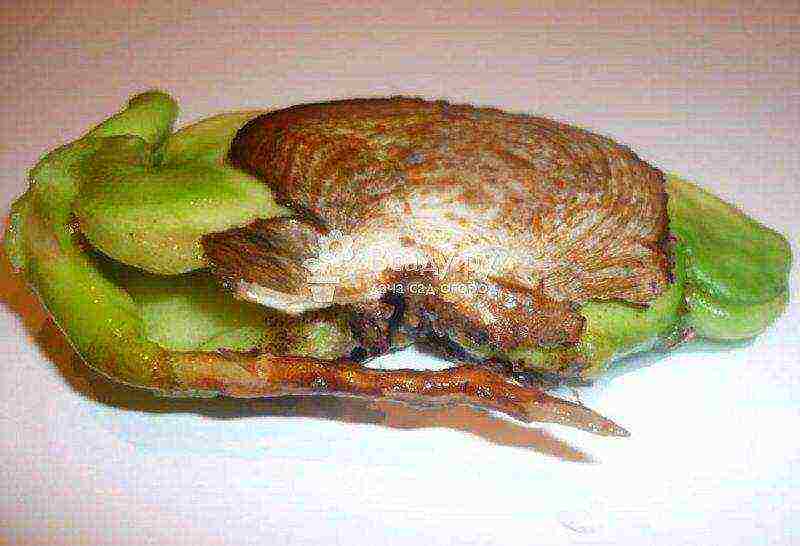 Ready-to-plant mango seed grain with germ
Ready-to-plant mango seed grain with germ
To create an ideal germination microclimate for mangoes at home, after planting, the pot with a bone should be covered with a thin glass sheet, cellophane, or a plastic bottle cut in half. Once every 2-3 days, slightly raise the edges of the shelter to ventilate and prevent the bone from rotting.
It is best to place the pot on a southern windowsill, where there is most sunlight. After two to three weeks, the first sprouts will appear and it will be possible to observe how the mango grows at home, then the shelter can be removed from the pot.
Mango tree at home: how to care Mango tree from a stone at home photo
If from the very beginning you took a small container for the mango, then you should postpone the further transplant. It is optimal to do this after the tree grows up a little and gets stronger. It will be possible to finally transplant the mango tree into a permanent container no earlier than in a year.Try to avoid frequent transplants, because each manipulation of this kind is stress for the plant, to which it can react by discarding leaves or even death.
Given the climate in which mangoes grow in their natural environment, it will be necessary to recreate these conditions as much as possible at home. The tree does not tolerate the dryness of the soil and air, therefore, do not forget to water it regularly, as well as maintain a sufficient level of humidity in the room (70-80%). At the same time, do not get carried away by over-spraying the leaves - they are very susceptible to fungi and mold, which can quickly develop and destroy the plant.
As a fertilizer for a mango grown from a seed or seedling at home, biohumus is suitable, as well as nitrogen-containing mixtures used for growing persimmons or citrus fruits. If you planted it in open ground, then 2 times a year do not forget to add organic substances (4-5 liters of water infused with manure or rotten leaves) to the trunk circle for feeding.
The plant desperately needs bright daylight, because the pot with it should be placed on the lightest window sill of the apartment, and in winter an additional light source will not interfere, you can use a fluorescent lamp.
Mango tolerates pruning well - you can shape its crown as you like. If you plan to leave the tree in the room, then after it reaches a meter, start pinching the top pairs of leaves together with the buds. The pruning sites must be treated with garden varnish.
Is it possible to get mango fruits at home How mango grows at home photo
Unfortunately, even if you follow all the instructions exactly, growing a mango from a seed at home will bring you an ornamental tropical plant with graceful leaves, reminiscent of a palm tree. Only grafted specimens can bloom and bear fruit. You can buy them in a botanical garden or nursery, or graft a plant by budding on your own, taking a bud from a fruiting one.
To plant a seed-grown mango tree:
Take a sterile sharp knife, cut off the bud with a piece of bark and wood. In your tree near the ground, make a small T-shaped incision with a sterile tool, gently peel back the edges of the bark and plant the cut kidney there. Wrap the graft with soft tape and wait for it to grow.
Mango can bloom 2 years after vaccination, and if this happens, then after 3 months (100 days) expect the first harvest of sweet, fragrant fruits. The grafted tree needs regular fertilization (it is necessary to water only with nitrogen-containing dressings and mixtures), especially during the period of flowering and ripening of fruits.
Growing mango from a stone at home: video instruction
Outcome
The mango tree is an unusual exotic plant that will not only become an excellent specimen of your collection, but can also bear delicious fruits if you follow some simple rules and instructions when planting and caring for it. And the main condition that must be met in order to get mango fruits at home is to plant the plant and provide it with high-quality and regular fertilization.
Mango is a wonderful exotic plant with aromatic and tasty fruits. It is grown in India, Thailand, Pakistan, Mexico, USA, Spain and Australia. You can meet it not only on plantations and in gardens, the plant is also grown in containers by amateur flower growers. It is quite possible to get a mango tree at home by planting a ripe fruit seed. At the same time, the process is simple, even a novice florist can handle planting. That's just to achieve fruiting mango in the room is unrealistic, he needs special conditions and pollinators.
Preparing mango seeds for planting
To prepare a mango seed for planting, you will need the following:
- ripe fruit;
- dull knife;
- paper towel;
- plastic bag with a zip fastener;
- plastic container with a lid.
Step-by-step master class on preparing mango seeds for planting
- Pick up the fruit, it must be ripe, regular in shape, without wormholes and damage. Then cut off the pulp, scrape off its remnants from the shells and rinse the pit with water.

The mango seed is taken from a ripe fruit
- Place the seed in a sunny place where it should dry out within 1–2 days. Flip it over when one side is dry.
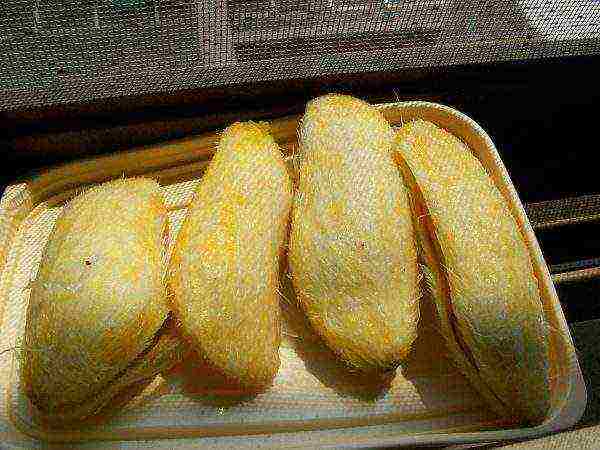
The seed must dry in the sun before extracting the seed.
- Use a blunt knife to carefully cut open the bone from the round tip, taking care not to damage the seed. Break the shell with your hands.

Open the bone with a blunt knife, being careful not to damage the seed
- Detach the bean-like or large bean-like seed from the shell. You do not need to remove the skin from it.
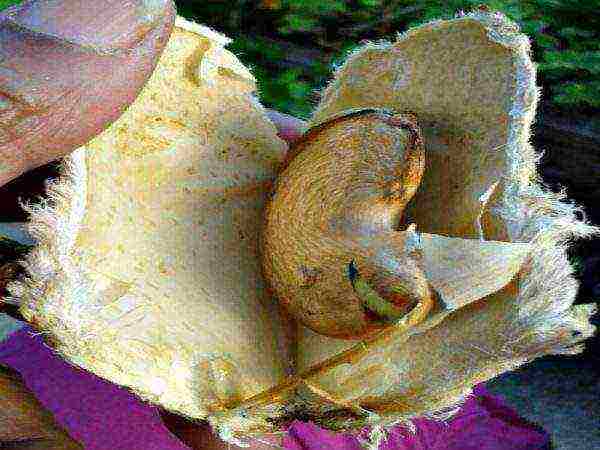
Inside the shell is a seed that looks like a bean
- Wrap the mango seed in a piece of paper towel and dampen it slightly. The material should not be too wet. Otherwise, the seed will simply rot.
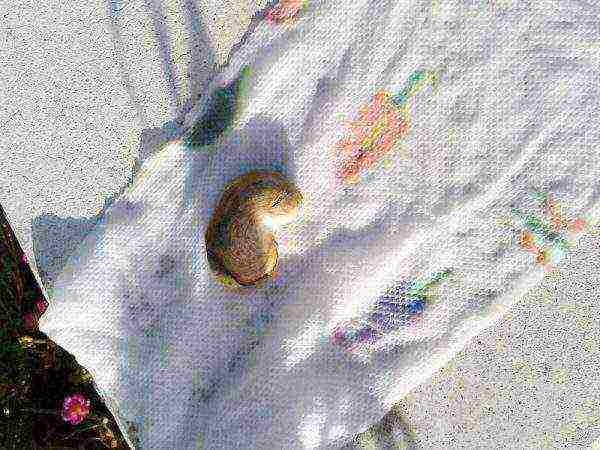
Mango seed is germinated in a humid environment by wrapping it in a wet paper towel
- Place the wrapped seed in a zip-fastened plastic bag and close it tightly, then place it inside the plastic food container. It will become your portable mini greenhouse.
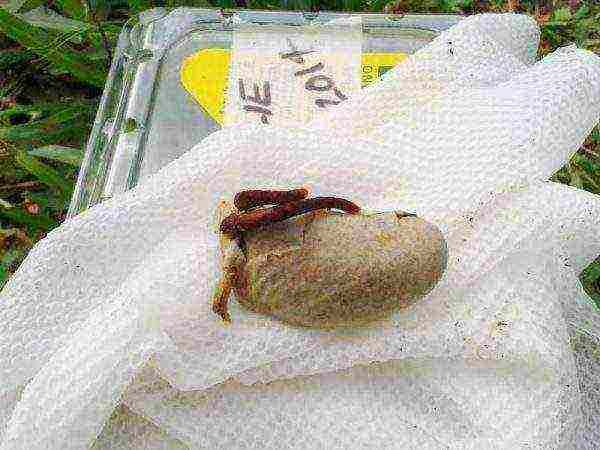
To germinate, wrap the seed in a damp paper towel, place in a bag and place in a plastic container
- Move the seed container to any dark place.
- Check the seed daily to keep it moist, but not wet.
Planting a sprouted mango seed
Mango seedlings are very vulnerable in the early stages, so it is best to plant the seeds right away in a permanent place in the pot.
For the procedure you will need:
- light and loose soil;
- drainage;
- flower pot;
- scoop;
- water.

Planting mangoes requires gardening tools, drainage and light, loose soil.
Soil for mango
The substrate for planting the king of fruits (as the mango is popularly called) should be light. You can use a mixture for succulents with the addition of small pebbles or expanded clay or universal soil mixed with sand 2: 1.
Planting stages of sprouted mango seed
- Place a 5 cm layer of fine gravel or expanded clay drainage at the bottom of the pot.

Mango does not tolerate stagnant water, therefore, to drain excess moisture, it is necessary to arrange drainage at the bottom of the pot.
- Fill the pot 2/3 full with soil, moisten it and let the water drain.
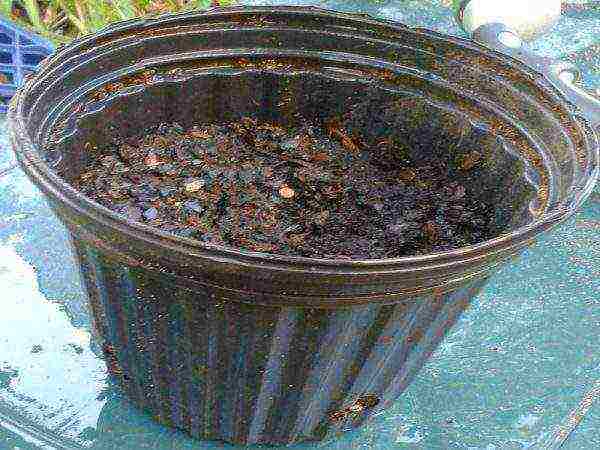
The soil is poured onto 2/3 of the pot
- Place the mango seed flat side down and cover gently with soil. Lightly press down on the soil, being careful not to damage the sprouted seed.

The seed is placed flat on a damp soil surface.
- Cover the planting with a plastic cup and place the pot in a sunny spot.
- Ventilate the makeshift greenhouse periodically and moisten the ground.
- Mango leaves will begin to appear in 2-4 weeks. Some of them will be colored bright green and others purple. Do not be alarmed, this is just a cultural feature.

Mango leaves are colored green and purple
- After two months, start gradually accustoming the seedling to the environment by opening the greenhouse. Three months after planting, you can remove the cup and transfer the small plant to an area with direct sunlight.
Video: how to grow a mango from a bone
Mango tree care at home
Germinating a mango seed and producing a seedling is only half the battle. In order for a plant to grow and develop well, it needs to create certain conditions. The mango should be placed on the sunniest windowsill, and in the summer it should be taken out to the balcony. The plant loves direct sunlight and warmth.
Watering and feeding
Indoor mango loves moisture. The plant needs regular watering, which should be carried out as soon as the top layer of soil in the pot dries up. To prevent moisture from evaporating longer, the soil can be mulched with humus or rotted sawdust.
Please note that although mango is moisture-loving, the plant does not tolerate stagnant water.
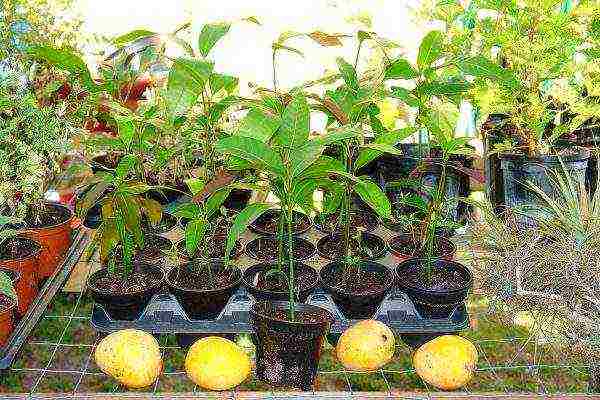
Three months after planting the seed in the pot, you can get real small trees.
Mangoes need organic feeding. It will be enough to add humus twice a year. To do this, make a small groove along the edge of the pot, pour humus into it and pour ordinary soil on top. This will provide the plant with everything it needs to grow well.
Mango crown formation
Mango responds very well to pruning and quickly regenerates its crown. The procedure is carried out when the mango tree grown in the room reaches 1.5 m in height. Pruning is done 1–2 times a year to maintain a beautiful shape and regulate the size of the plant.
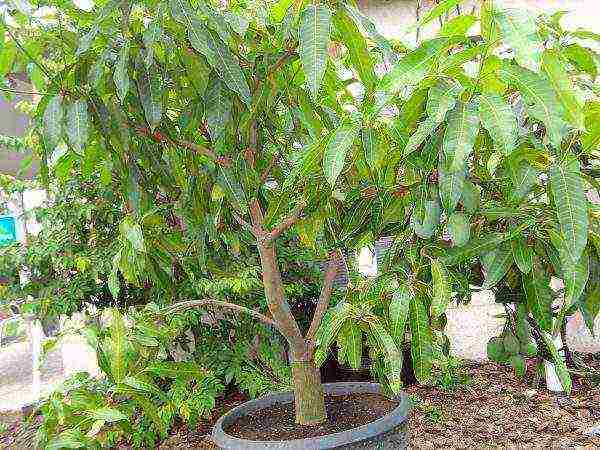
Mango at home has an attractive appearance.
There are no special rules for the procedure. All branches thickening the crown are cut out and the central one is shortened to the desired size. You can also give the crown of a mango the desired look, forming it in the form of a ball, pyramid or a picturesque spreading bush.
Video: how to grow a mango tree at home
When growing mango at home, do not expect flowering and fruiting from it. Even if it is possible to provide all the necessary conditions for a tropical plant, to provide it with a warm, humid and sunny place, the mango will not be able to develop the powerful root system characteristic of the culture. But even if you cannot get tasty fruits, mango will become a wonderful decoration at home, the plant, which is exotic for our latitudes, has a very attractive look.
A tropical plant like mango has very tasty and juicy fruits, which contain a large amount of nutrients and vitamins. But is mango suitable for indoor cultivation, and how to properly care for it?
This evergreen tree is recommended to be grown from sprouts, which are quite possible to buy in a special nursery. The planted sprout takes root relatively well and does not require close attention during growth. And also a wild plant will definitely not grow out of it. But you can also grow a mango from an ordinary stone, which should be taken from a ripe fruit. It is quite possible to germinate it, you just need to adhere to certain rules.
Growing mangoes indoors
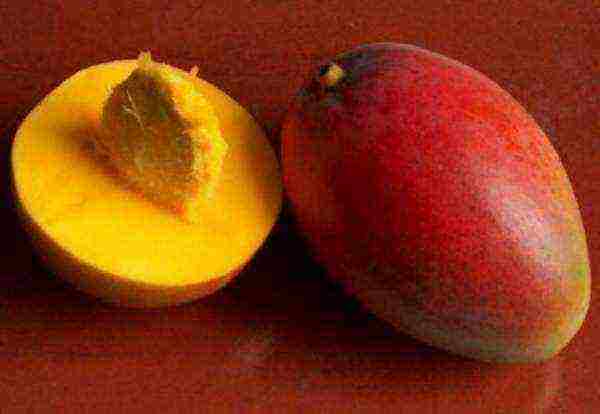
The seed should be planted almost immediately after it is removed from the fruit. At the same time, you should definitely choose ripe mango. It is very easy to check whether the fruit is suitable for the degree of maturity. So, in a suitable mango, the bone can be separated from the pulp very easily. First, wash it thoroughly and then remove the remaining pulp using a sharp knife. After that, the prepared bone is gently split, thereby accelerating the germination process:
- In the event that the bone cracks without problems, the shell should be removed from it, while taking out the inside neatly, very similar to the beans. After that, it should be treated with fungicides - agents that can resist the development of fungus and harmful spores. In the event that there is not one, but several embryos inside, then it is necessary to choose only one of the greenest and smoothest of them, since its chances of germination are greater than those of the others.
- In the event that it is very difficult to crack the shell, then no effort is needed, otherwise the inner part can be damaged. The mango seed should be placed in a container, which must be transparent and pour water at room temperature into it. For the bone, you should choose the lightest place on the windowsill. So, she should lie for several weeks.But at the same time, you must not forget to change the water every couple of days, otherwise it will turn sour.
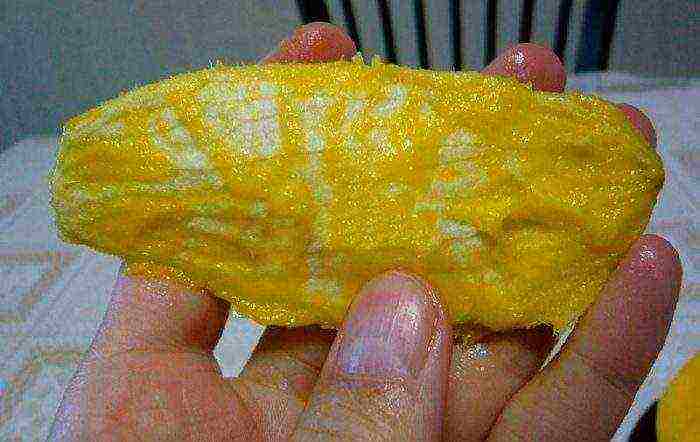
Then you need to choose a suitable pot. Due to the fact that a mango tree in nature can reach a height of 10–45 meters, the container for planting should be taken at once rather large. In this case, replanting the plant, and therefore injuring the root system, you will be less. Be sure to make good drainage at the bottom of the container, for this use special granules or small gravel. The drainage layer is able to prevent stagnation of liquid in the soil, and hence the appearance of rot on the roots. For planting, you can use purchased universal soil, but it should be noted that it must be neutral in acidity.
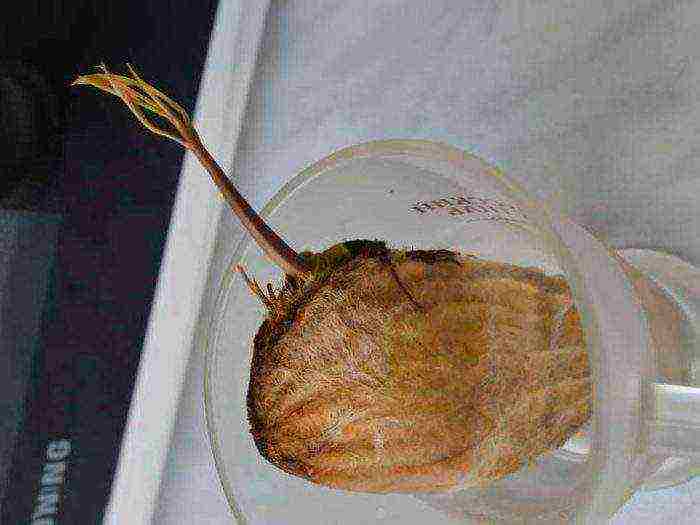
In order to measure the acidity of the soil, you can use a device specially designed for this, which is called a soil pH meter or a pH meter. It can also be replaced with disposable indicators made of paper. They change their color shade after contact with acidic soil (this happens within 1-15 minutes, and the time depends entirely on the indicator manufacturer).
You can plant in two ways:
- placing it sideways - in the event that you do not know exactly where the lower part is, and where the upper part is;
- placing horizontally - if there is already a small sprout.
You should not completely sprinkle the bone with soil, its fourth part should rise above the surface. After planting, spill the soil well, and if it settles hard enough, you will need to fill it up a little to the required level.

To create the most suitable conditions for germination, it is necessary to close the container on top with glass, transparent film or ½ part of a plastic bottle. Do not forget to air the mango, for this, once every 2 or 3 days, slightly raise the edges of the shelter. This will help you avoid bone decay.
The sill of a south-facing window is perfect for placing the pot, since the plant requires the greatest amount of light. After 2-3 weeks, a sprout usually appears and the mango begins to grow. After that, you need to remove the shelter from the container.
Care features
In the event that you planted the mango in a not very large pot, then you should not rush to transplant it. This procedure is recommended only after the plant becomes strong and grows a little. Transplanting into a permanent pot should be done for a plant that has reached one year of age. It is not necessary to transplant the plant very often, since the mango reacts extremely negatively to this procedure, and as a result, it can shed all the leaves or even die altogether.
In order for a plant to grow and develop normally, it needs conditions as close as possible to natural ones. It reacts negatively to dryness of the soil, as well as to low air humidity. In this regard, he needs to ensure systematic watering, and he also needs to have a constantly high humidity in the room (about 70-80 percent). Too often it is not worth moistening foliage from a sprayer, as this can provoke the appearance of mold and mildew. And they, rapidly developing, can even destroy the mango.
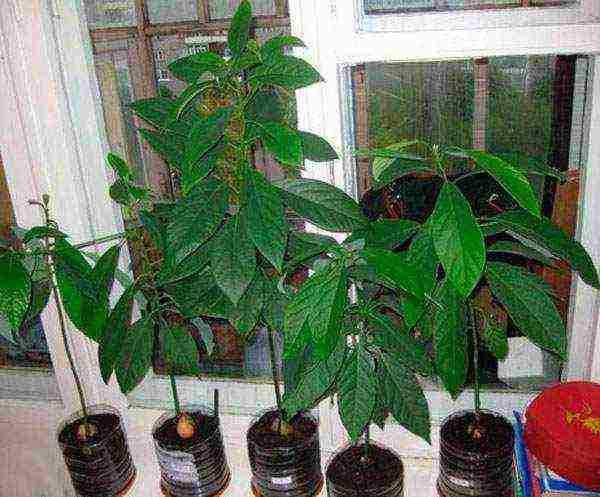
Fertilizer for mango, which was grown from a seedling or from a seed in room conditions, can be vermicompost and mixtures containing nitrogen, which are used in the cultivation of citrus fruits, as well as persimmons. In the event that your mango grows in the open field, organic fertilizers should be applied to it in the trunk circle a couple of times a year as a top dressing. So, 4 or 5 liters of water can be insisted on rotten foliage or manure.
The plant needs good sunlight. In this regard, the lightest window sill is chosen for its placement. Supplementary lighting is recommended in winter, which can be done with fluorescent lamps.
This tree tolerates the pruning procedure quite well, so you can shape the crown the way you want. In the event that the mango grows constantly in the room, and you are not going to plant it in open ground, it will definitely need systematic pruning. When it grows to a meter in height, it is necessary to start pinching the upper pairs of leaves, and they should be removed along with the buds.
Obtaining fruits at room conditions
Even if you follow exactly the above instructions for growing mango from a stone, this plant will only decorate the room with its spectacular foliage, outwardly somewhat reminiscent of a palm tree. Flowering and fruiting is available only to grafted plants. It is quite possible to purchase already grafted mangoes in a nursery or a botanical garden, and you can also graft a plant by budding with your own hands, while you will need a bud from a fruiting specimen.
Grafting mango

You will need a sharp, sterile knife for this procedure. They need to carefully cut the bud with some wood and bark. On the tree to be grafted, you need to make a not very large cut, resembling the letter T. Then carefully peel back the edges of the bark and insert the cut bud. The incision should be carefully wrapped with soft tape, and it can be removed after the bud has grown.
The first flowering after grafting usually occurs after a couple of years. After 100 days (3 months) after the flowers appear, you can enjoy the juicy fragrant fruits. A tree that has been grafted needs systematic feeding (watering should be carried out only with fertilizing and mixtures containing nitrogen). Especially mango needs fertilization during flowering and during the ripening period.
Such a beautiful tree can become a real decoration of any room, but only if it is properly looked after and provided with the necessary conditions of detention. And to get sweet fruits, you will need to graft the plant and systematically fertilize it after that.

